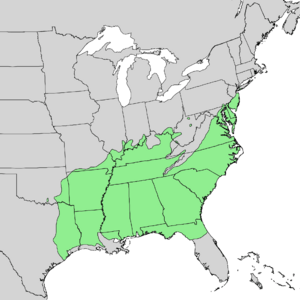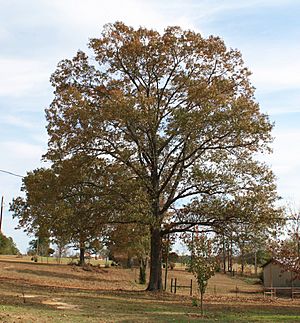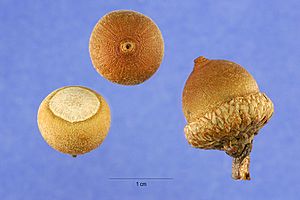Southern red oak facts for kids
Quick facts for kids Southern red oak |
|
|---|---|
 |
|
| Leaf and bark | |
| Conservation status | |
| Scientific classification | |
| Genus: |
Quercus
|
| Species: |
falcata
|
 |
|
| Synonyms | |
|
List
Quercus aurea Raf.
Quercus digitata Sudw. Quercus elongata Muhl. Quercus hudsoniana Dippel Quercus hypophlaeos Petz. & G.Kirchn. Quercus nobilis K.Koch Quercus triloba Michx. |
|
The Quercus falcata, also known as the southern red oak, is a type of oak tree. It is native to the southeastern United States. It got the name "Spanish Oak" because it grows in areas where early Spanish colonies were located. The name "southern red oak" comes from where it grows and the color of its leaves in late summer and fall. This tree is a deciduous plant, which means its leaves fall off each year and grow back in the spring.
Contents
About the Southern Red Oak

The southern red oak is a medium to large tree. It usually grows about 25 to 30 meters (82 to 98 feet) tall. Some very tall trees in forests can reach 35 to 44 meters (115 to 144 feet). Its trunk can be up to 1.5 meters (5 feet) wide. The top part of the tree, called the crown, is wide and round.
Its leaves are 10 to 30 centimeters (4 to 12 inches) long and 6 to 16 centimeters (2.4 to 6.3 inches) wide. They have 3 to 5 pointed lobes, which are often curved. These lobes have a small, stiff point at the tip. The middle lobe is usually long and narrow. This unique shape helps tell it apart from other red oaks. The bottom of the leaf is rounded and often a bit lopsided. The top of the leaves is dark green and shiny. The underside is rusty colored and hairy, especially along the main veins.
The seeds of the southern red oak are called acorns. They are 9 to 16 millimeters (0.35 to 0.63 inches) long and are bright orange-brown. The acorn sits in a flat cup that covers about one-third to half of its length. Acorns take two years to fully grow. The tree's bark is dark brownish-gray with shallow ridges.
Southern red oaks can sometimes mix with other red oak species to form hybrids. These trees can grow in many parts of the eastern United States. They can survive cold temperatures down to about -23°C (-10°F) and hot temperatures up to 38°C (100°F).
Famous Southern Red Oaks
One famous southern red oak was in Queen Anne's County, Maryland. It was known as the largest southern red oak in that area. This old tree was at least 200 years old. It stood 20 meters (66 feet) tall and its branches spread out 31 meters (102.5 feet) wide. Sadly, it fell down on July 23, 2017, during a tornado.
Where Southern Red Oaks Live
Southern red oaks grow in sandy, loamy, or clay soils. These soils are often dry, acidic, and do not have many nutrients. You can find this tree from southern New York (on Long Island) all the way south to central Florida. It also grows west to Missouri, Oklahoma, and Texas. In the northeastern part of its range, it is quite rare and mostly found near the coast. It is most common in the Piedmont region of the Southeast.
How Southern Red Oaks Are Classified
The southern red oak belongs to the beech family, called Fagaceae. It is one of 207 oak species found in the U.S. It is part of the Lobatae section of the Quercus genus, which includes all the red oaks.
The southern red oak was first described in 1801 by a scientist named Andre Michaux. It has several other names that have been used for it, such as Quercus aurea, Quercus digitata, and Quercus triloba. Some hybrid trees have also been identified, like Quercus × caesariensis, which is a mix of Q. falcata and Quercus ilicifolia.
The Meaning of Its Name
The name Quercus is a Latin word for "Oak." The second part of its scientific name, falcata, is also Latin. It means "sickle-shaped." This refers to the curved, sickle-like shape of the lobes on its leaves.
Uses of Southern Red Oak
The southern red oak is a very useful tree. Its wood is strong, durable, and has a coarse grain. This makes it great for making floors, furniture, and building materials. It is very important in the southeastern United States because there are so many of these trees. About 8.1% of the hardwood harvested each year comes from the southern red oak.
The wood is also used as a fuel source because it burns very well and gives off a lot of heat. Southern red oak trees also provide tannin. Tannin is a substance used to preserve and treat leather.
The southern red oak has a large root system. This helps protect watersheds, which reduces flood damage and keeps the soil stable. People also plant southern red oaks as shade trees in gardens and parks because they look nice. The acorns from these trees are an important food source for many animals, including deer, squirrels, turkeys, songbirds, and quail.
Oak Wilt Disease
Southern red oaks, like other oak species, can get a disease called oak wilt. This disease is caused by a fungus called Ceratocystis fagacearum. When the fungus infects the tree, its leaves start to wilt. This reduces how much food the tree can make, and it can even die. The fungus gets into the tree's water pipes (called xylem) and blocks them. This stops water from moving up the tree.
Even though oak wilt is not currently causing a big problem for the southern red oak population, efforts are being made to stop it. This is because the southern red oak is very important to its ecosystem. To manage oak wilt, people use a few methods:
- Root disruption: This means creating barriers, like trenches, to stop the roots of infected trees from touching the roots of healthy trees. This prevents the fungus from spreading underground.
- Sanitation: This involves removing infected trees to get rid of the source of the disease. Sometimes, all trees in an infected area are removed.
- Chemical application: Fungicides can be sprayed on healthy trees to protect them from getting sick. There are also fungicides that can help reduce the symptoms in trees that are already infected, though they cannot cure the tree. A common fungicide used is propiconazole.
See also
 In Spanish: Roble rojo del Sur para niños
In Spanish: Roble rojo del Sur para niños



